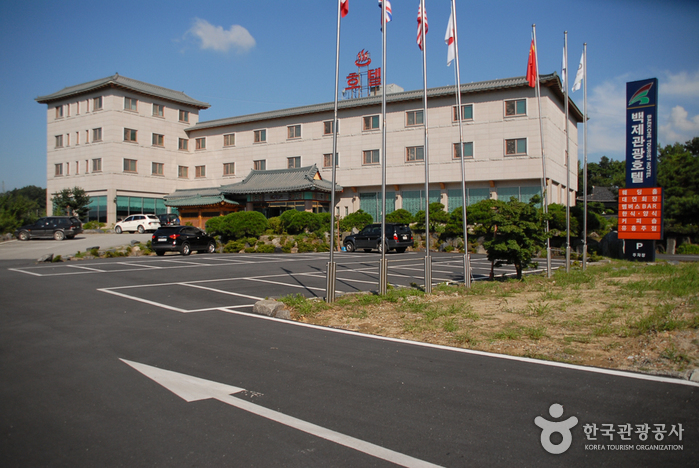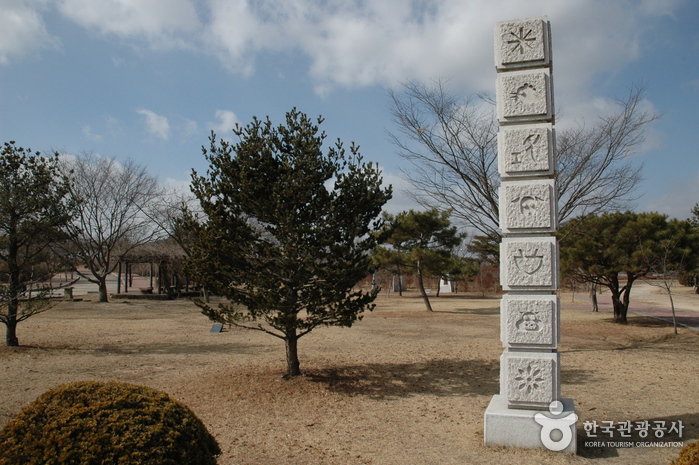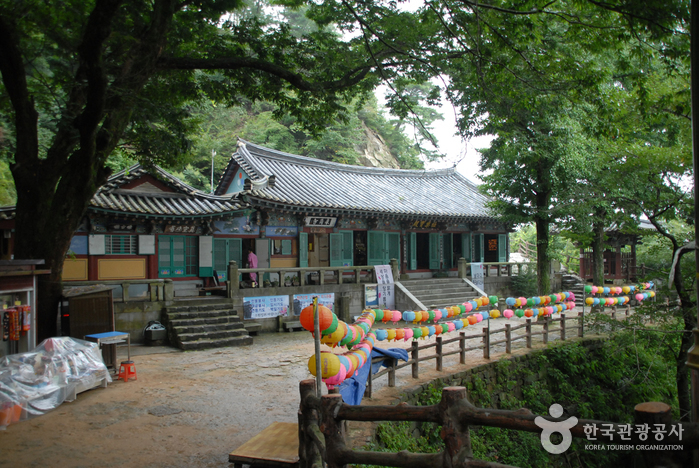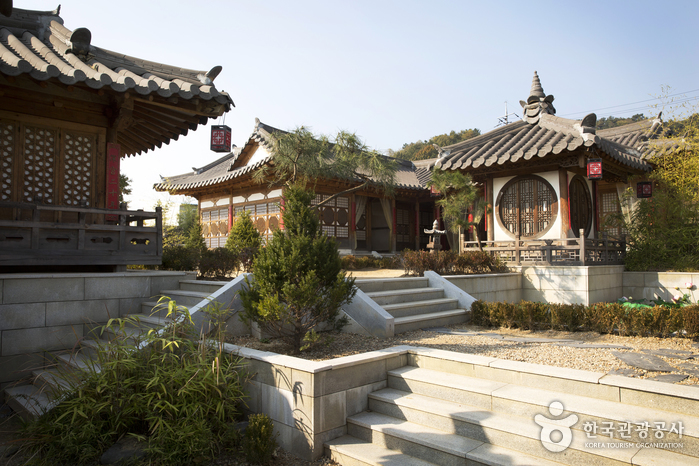Archaeological Site in Gwanbuk-ri and Busosanseong Fortress [UNESCO World Heritage] (관북리유적과 부소산성 [유네스코 세계유산])
16.0 Km 53616 2024-02-29
Gua-ri & Gwanbuk-ri, Buyeo-eup, Buyeo-gun, Chungcheongnam-do
+82-41-830-2880
Archaeological Site in Gwanbuk-ri and Busosanseong Fortress are historical sites dating back to the Baekje period (BC 18-AD 660), when they served as the capital from 538 to 660 AD. Archaeological Site in Gwanbuk-ri functioned as the royal palace where the king resided and governed during peacetime, while Busosanseong Fortress served as a defensive wall for wartime preparedness. Many Baekje historical relics have been excavated from these sites, and there is a virtual experience center called Sabido Fortress for visitors to explore, along with guided tour services available.
Kudurae Dolssambap (구드래돌쌈밥)
16.2 Km 7483 2024-03-28
31 Naruteo-ro, Buyeo-eup, Buyeo-gun, Chungcheongnam-do
+82-41-836-9259
Kudurae Dolssambap is situated on the Goodtrae Food Street in Buyeo, the historic capital of the Baekje kingdom. The restaurant is renowned for its dolssambap - a nutritious set meal consisting of rice cooked in a hot stone pot, accompanied by a selection of vegetables and side dishes. This signature dish emphasizes the use of medicinal plants and vegetables, promoting a wholesome dining experience.
Baekche Tourist Hotel (백제관광호텔)
16.2 Km 10230 2020-04-09
108, Bukpo-ro, Buyeo-gun, Chungcheongnam-do
+82-41-835-0871
Baekche Tourist Hotel is located in the center of the city of Buyeo, and has built up a reputation as an excellent hotel. It has Western-style rooms and Korean-style rooms and can accommodate up to 230 guests at once. The hotel also has a banquet room and a wedding hall to serve as a venue for various activities and events.
Gudeurae Park (구드래조각공원)
16.4 Km 12122 2020-03-18
60, Naruteo-ro, Buyeo-gun, Chungcheongnam-do
+82-41-830-2880
Located at the western end of Busosan Mountain along the Baekma River, the Gudeurae region boasts beautiful scenery and a well-developed sculpture park. The port in the region acted as an entrance to the Sabi Castle during the Baekje dynasty and today serves as a dock for the cruise ship that travels up and down the Baekma River. Restaurants serving delicious regional cuisine are located near the dock, making the area a recommended tourist location for visitors who are looking for a combination of natural beauty and flavorful culinary delights.
Gudeurae was designated a Korea tourist region in 1985. Following the official designation, a sculpture park housing 59 sculptures was established in the area. Thirty of the works of art were crafted by sculptors residing in Gudeurae who are known for skills that have been handed down from artists dating back to the Baekje Period. The other 29 pieces are from Korean and overseas artists who participated in the International Modern Sculpture Symposium in 1999. The sculptures bring about a sense of beauty that reflects the region’s history as well as modern art, making the park a popular tourist site and retreat for residents. A monument built in memory of a well-known folk song describing the beauty of Gudeurae is also located in the region.
Goransa Ferry (고란사유람선)
16.5 Km 33364 2020-02-07
Buso-ro, Buyeo-gun, Chungcheongnam-do
+82-41-835-4689
Goransa Ferry is the best way to understand the history of the Baekje dynasty while enjoying the still waters of Baengmagang River. The ferry passes various historical sites within Busosanseong Fortress, including Cheonjangdae Cliff, Nakhwaam Rock, Joryongdae Cliff, and Jaondae Cliff. Of these sites, Nakhwaam Rock (Falling Flower Rock) is perhaps the most famous, being known as the location where many Baekje women jumped from the cliff rather than be taken captive when the dynasty fell to invading forces. Another key site is Goransa Temple, home to a fountain of natural spring water that was said to prevent aging.
Goransa Temple (고란약수)
16.7 Km 10497 2021-11-26
1-25, Buso-ro, Buyeo-gun, Chungcheongnam-do
+82-41-830-2623
Goransa Temple is located at the foot of the cliffs of Nakhwaam before the Baengmagang River. There is a well called Goranjeong behind the temple. The kings of Baekje are said to have drank water from this well at least once a day. It is said the water will make anyone who drinks it become three years younger.
KT&G Sangsangmadang Nonsan (KT&G 상상마당 논산)
16.7 Km 20541 2018-09-06
15-20, Hancheon-gil, Sangwol-myeon, Nonsan-si, Chungcheongnam-do
KT&G Sangsangmadang are cultural arts facilities located in Hongdae, Chuncheon, and Nonsan. The Nonsan branch includes basic facilities such as a design shop, café, and experiences, while also offering an art lounge, art camping village, and youth training facilty for more indepth education. Sangsangmadang’s lives out its concept of growing artistic imagination and sharing happiness.
Myeongrjaegotaek [Korea Quality] / 논산 명재고택 [한국관광 품질인증]
16.8 Km 10551 2023-11-29
50 , Noseongsanseong-gil, Nonsan-si, Chungcheongnam-do
+82-41-735-1215
Myeongjae Old House in Nonsan, Chungcheonbuk-do, was the house of Yun Jeung, a Joseon scholar of King Sukjong’s time. The house stands open to the village without a tall gate or fence, and consists of a sarangchae (men’s house) and gotganchae (storehouse) arranged protectively around the anchae (women’s house). The sarangchae has three guest rooms and a porch offering scenic views. Bathrooms and toilets are modern and clean. There is a thatched outbuilding with sound equipment and a beam projector for meetings. Cultural experience programs offered include traditional Korean music, a tea ceremony, and natural dyeing.
Seodongyo Theme Park (서동요 테마파크)
16.9 Km 15654 2021-06-10
616, Chungsin-ro, Buyeo-gun, Chungcheongnam-do
+82-41-832-9913
Seodongyo Theme Park is an open film set studio in a huge 33,000 square meter plot of land. The theme park offers various sets from Goryeo to Joseon dynasty as well as royal residences of Baekje dynasty, the commoners’ village, the village of the nobles and more. The set was the backdrop of various dramas including “Ballad of Seodong (2005), “The Great Sheer (2012)” and more. Visitors can also engage in various experience programs.
Mireuksa Temple Site [UNESCO World Heritage] (익산 미륵사지 [유네스코 세계문화유산])
17.0 Km 22104 2024-04-07
362, Mireuksaji-ro, Iksan-si, Jeonbuk-do
+82-63-859-3873
Mireuksa was the largest Buddhist temple of the ancient Baekje Kingdom (18 BC-AD 660). According to Samgukyusa (historical records published in 1281), King Mu (30th king of Baekje, in power AD 600-641) and his wife Queen Seonhwa were said to have seen a vision of Mireuksamjon (the three Sanskrit) emerging from a large pond. At the time of their revelation, the king and queen were on their way to visit a Buddhist monk in Sajasa Temple on Yonghwasan Mountain (now known as Mireuksan Mountain). In response to their vision, the king drained the nearby pond and established Mireuksa Temple. The temple is believed to have shown the most advanced architectural and cultural skills of Baekje, Silla, and Goguryeo (the three main kingdoms at that time). Records indicate that King Jinpyeong of Silla even sent his craftsmen over to assist with the temple construction.
The two main features of the Mireuksa Temple Site are the stone pagoda (Mireuksaji Seoktap) and the flagpole supports (Mireuksaji Dangganjiju). The 14.24-meter-high west stone pagoda (National Treasure No. 11) is the oldest and largest Korean stone pagoda in existence. The west pagoda currently has only six tiers, but is estimated to originally have had nine. The nine-story east stone pagoda (27.67 meters in x_height) was restored to its original stature in 1993 based on historical records. Other surviving landmarks include the flagpole supports (Treasure No. 236) to the south of the stone pagodas. The 395 centimeter-tall poles are estimated to have been created during the Unified Silla period (AD 676-935) and are set 90 meters apart from east to west.
![Archaeological Site in Gwanbuk-ri and Busosanseong Fortress [UNESCO World Heritage] (관북리유적과 부소산성 [유네스코 세계유산])](http://tong.visitkorea.or.kr/cms/resource/33/2366333_image2_1.jpg)





![Myeongrjaegotaek [Korea Quality] / 논산 명재고택 [한국관광 품질인증]](http://tong.visitkorea.or.kr/cms/resource/55/3036955_image2_1.jpg)

![Mireuksa Temple Site [UNESCO World Heritage] (익산 미륵사지 [유네스코 세계문화유산])](http://tong.visitkorea.or.kr/cms/resource/91/2514991_image2_1.jpg)
 English
English
 한국어
한국어 日本語
日本語 中文(简体)
中文(简体) Deutsch
Deutsch Français
Français Español
Español Русский
Русский